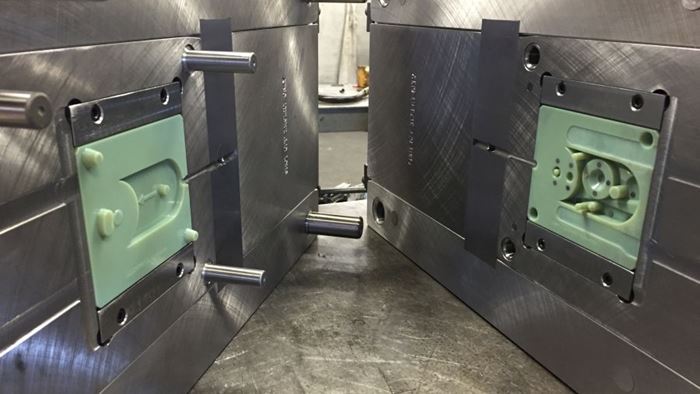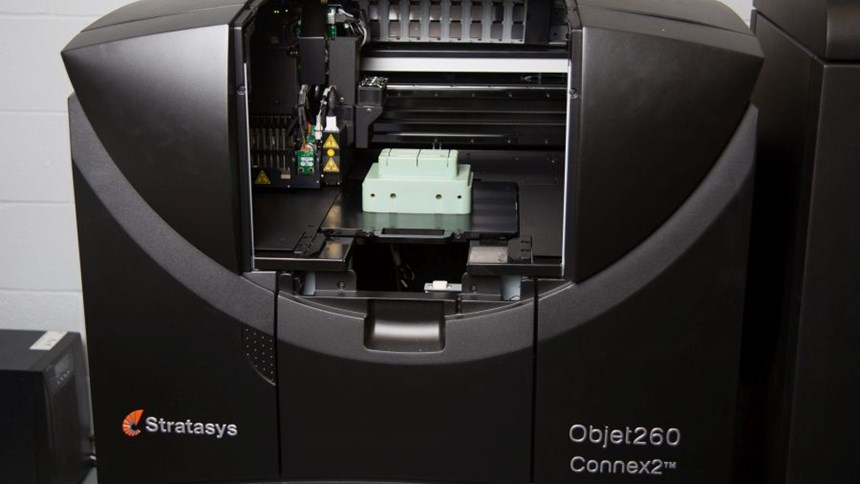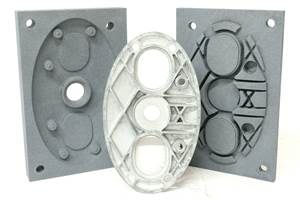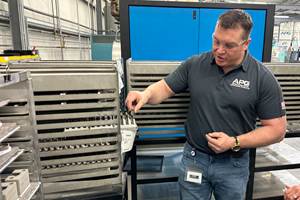Expanding Horizons with Rapid Tooling
Investing in 3D printing for rapid tooling brought product development time from months down to weeks for this moldmaker.
Share
Read Next
Providing customers with the ability to produce a production-intent component in the production-specified engineered resin in days rather than weeks is the goal of many mold manufacturers and molders. But today, Accu-Mold LLC, a certified minority business enterprise based in Portage, Michigan, can say they reached that goal. The company recently invested in rapid tooling capabilities using 3D printing.
After years of outsourcing 3D printing, Accu-Mold decided to install a Stratasys Objet260 Connex2 and Objet30 Pro mid-2015 to print sample parts and molds to speed product development time for its customers.
Accu-Mold specializes in metal to plastic conversion, but didn’t just want to deliver 3D-printed components. They wanted to leverage additive manufacturing (AM) for rapid tooling development, according to Accu-Mold President Dave Felicijan.
The addition of AM for rapid tooling affords their customers a much shorter lead time over multiple standard aluminum prototype molds and trials. 3D-printed rapid tools can be turned around within three to six business days while maintaining the integrity of the production-intent material for both design and product validation.
And with the analytical design tools at their disposal, such as MoldFlow, FEA and cooling analysis, and the ability to prototype quickly, Accu-Mold can ensure an efficient manufacturing process within weeks as opposed to months. This means their customers get their products to market much sooner.
To date, Accu-Mold has produced a number of printed tools and each one presents its own set of challenges. For example, getting cooling into the mold or using some type of system to quickly cool the part before ejection. “To date, we have printed three tools and their respective molded parts. We also have two more in design. The first three were single-cavity prototype tools and the other two in design are single-cavity production pull ahead tools,” says Felicijan.
The first rapid tooling project was for the welding aftermarket component industry. The part is used for wire welding and is assembled in a “chain” to straighten the wire as it is pulled from a distance. The geometry of the part proved to be challenging due to thin walls and deep draw. However, Accu-Mold used recommended guidelines for the ratio of wall thickness, maximum material load, etc. from the printer manufacturer, as well as experience with standard tooling prototypes and scientific molding, to design and build the rapid tool.
Stratasys’ digital ABS material was used along with proprietary cooling, and runner and gate sizing calculations based on product size, material and wall thickness. The tool was built in four business days with molded production-intent components on the fifth business day. This project saved thousands of dollars in labor and material compared to a standard aluminum prototype tool.
Felicijan notes that Accu-Mold’s customers have been eager to use the rapid tooling capability for components that would normally take 12 to 14 weeks for prototyping and design validation testing. “When the process is presented to the customer, they want to use it right away. However, it doesn’t meet the needs of all applications. It’s important to act quickly yet realistically based on the variables presented. For example, we have development underway for higher temperature materials,” says Felicijan.
Currently, about 60 percent of Accu-Mold’s business is mold building and 40 percent is automotive and commercial molding. The company is looking to use its new AM capabilities to diversify into medical and defense products because of their reduced product life cycles and legacy component and assemblies, respectively. Additionally, Accu-Mold hopes to achieve a higher concentration of contract manufacturing by expanding into advanced AM, including metal 3D printing.
Related Content
Foundry Lab: How Casting in a Day Will Improve the Design of Metal Parts (Includes Video)
The company’s digital casting process uses 3D printing, but the result is a cast part. By providing a casting faster than a foundry, the company says effective prototyping is now possible for cast parts, as well as bridge production.
Read MoreBridge Production Is Real Production
Not prototyping — it is something far more than this. The chance to launch the product into the world using additive manufacturing as the initial process delivers important new possibilities, and even keeps on delivering advantages far into the product’s life.
Read MoreSinter-Based Additive Manufacturing Finds a Place Alongside MIM, Press and Sinter at APG
Powder metallurgy company Alpha Precision Group (APG) is applying a particular class of metal 3D printing technology for both rapid iteration in development and flexibility in production.
Read MorePowderCleanse Concept Delivers In Situ Powder Analysis for Metal 3D Printing
A collaborative project developed a prototype solution for measuring particle size distribution on the production floor, as part of the sieving step typical to additive manufacturing processes using metal powders.
Read MoreRead Next
Hybrid Additive Manufacturing Machine Tools Continue to Make Gains (Includes Video)
The hybrid machine tool is an idea that continues to advance. Two important developments of recent years expand the possibilities for this platform.
Read MoreAt General Atomics, Do Unmanned Aerial Systems Reveal the Future of Aircraft Manufacturing?
The maker of the Predator and SkyGuardian remote aircraft can implement additive manufacturing more rapidly and widely than the makers of other types of planes. The role of 3D printing in current and future UAS components hints at how far AM can go to save cost and time in aircraft production and design.
Read More3D Printing Brings Sustainability, Accessibility to Glass Manufacturing
Australian startup Maple Glass Printing has developed a process for extruding glass into artwork, lab implements and architectural elements. Along the way, the company has also found more efficient ways of recycling this material.
Read More























